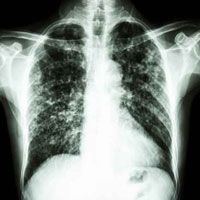Underutilized Treatment Beneficial for Genetically-driven Emphysema
Investigators at Toronto Western Hospital deemed an existing - but not widely used - augmentation therapy effective at treating genetically-motivate emphysema.

Investigators at Toronto Western Hospital deemed an existing — but not widely used — augmentation therapy effective at treating genetically-motivate emphysema.
Without having a history of smoking, individuals with inadequate amounts of α1 antitrypsin (AAT), a lung-protecting protein, are at risk for developing emphysema as AAT ends up accumulating in the liver. According to a statement, around 5% of chronic obstructive pulmonary disease (COPD) patients have AAT deficiency. However, it took researchers 5 to 10 years to connect the deficiency to respiratory diseases, leading to a majority of these COPD patients not being identified.
Published in The Lancet, the study involved recruiting 180 non-smokers aged 18-65 who had severe AAT deficiency (serum concentration <11 μM) and a forced expiratory volume in one of 35—70% who were subjected to either α1 proteinase inhibitor (A1PI) augmentation treatment, which included intravenously 60 mg/kg per week, or placebo treatment for 24 months.
Patients were excluded from their research if they had underwent or were planning to undergo lung transplantation, lobectomy, or lung volume-reduction surgery, or had selective immunoglobulin A (IgA) deficiency.
After 24 months, the investigators found no difference in degradation in their combined total lung capacity (TLC) and functional residual capacity (FRC) between the two groups (A1PI −1·50 g/L per year [SE 0·22]; placebo −2·12 g/L per year [0·24]; difference 0·62 g/L per year [95% CI −0·02 to 1·26], p=0·06). However, they noted the A1PI group (−1·45 g/L per year [SE 0·23]) had a smaller decrease in their TLC scores than patients who were on placebo (−2·19 g/L per year [0·25]; difference 0·74 g/L per year [95% CI 0·06—1·42], p=0·03),
To remedy AAT deficiency, augmentation therapy involves injecting purified AAT to raise levels in the patient’s blood and lungs. While this treatment had been available for more than 25 years, doctors don’t widely use the therapy due to its complexity, the statement also pointed out.
"Augmentation therapy not only preserves lung structure, but likely adds years of life," lead researcher Kenneth Chapman, Director of the Asthma and Airways Centre at Toronto Western Hospital said. "Patients with this condition need access to timely diagnosis and treatments to ensure they receive the best possible care".
While he and his team touted the benefits of augmentation therapy, they cautioned that the therapy wouldn’t be effective for patients with common types of COPD, emphysema, or chronic bronchitis.
“Measurement of lung density with CT at TLC alone provides evidence that purified A1PI augmentation slows progression of emphysema, a finding that could not be substantiated by lung density measurement at FRC alone or by the two measurements combined,” the authors concluded. ”These findings should prompt consideration of augmentation treatment to preserve lung parenchyma in individuals with emphysema secondary to severe α1 antitrypsin deficiency.”